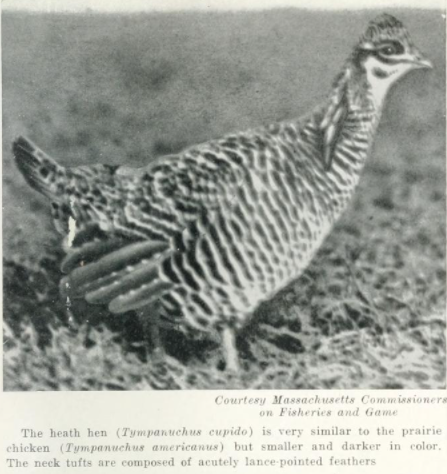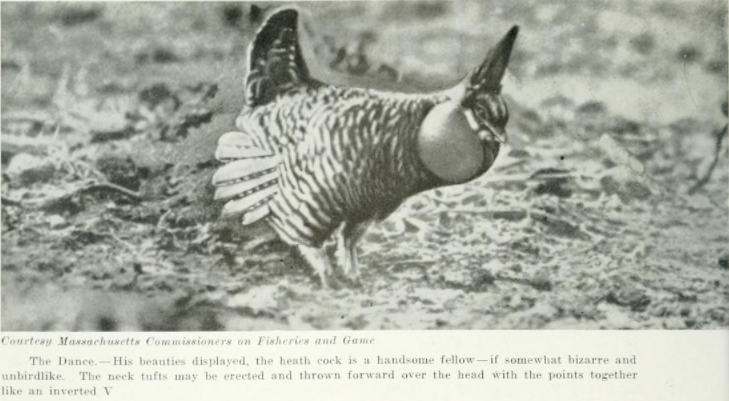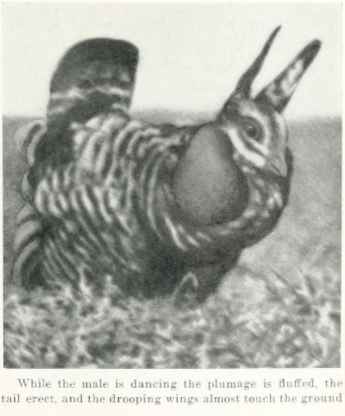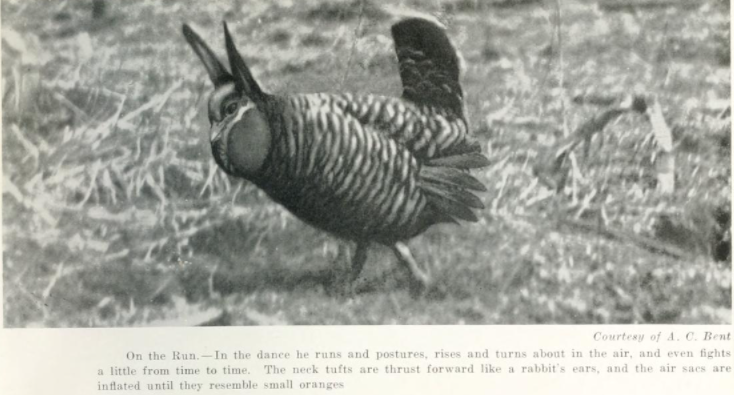Tympanuchus cupido cupido Linnaeus, 1758:160
Heath hen, Martha's Vineyard sage-hen
Taxonomy & Nomenclature
Synonym/s: Tetrao cupido Linnaeus, 1758:160
Conservation Status
Extinct
Last record: 11 March 1932
IUCN RedList status: Extinct
The Heath hen (Tympanuchus cupido cupido) was extirpated from mainland USA during the 1800's and thereafter survived only on Martha's Vineyard, an island in Buzzard's Bay, Massachusetts (Fuller, 1987:60). Prior to it's death, the last known Heath hen seems to have survived almost 3 and a half years longer than the second last known Heath hen, which was last recorded in December, 1928 (Ibid.).
Distribution
Connecticut, Maryland, Massachusetts, New York, New Jersey & Pennsylvania, USA
Biology & Ecology
Hypodigm
1 specimen is in the collection of the New York State Museum: http://www.nysm.nysed.gov/treasures/treasure.cfm?object=391988
Audie Murphy/American Cotton Museum in Greenville, Texas at least one specimen
Media
Photos

Above: published in Forbush (1919).

Above: published in Forbush (1919).

Above: published in Forbush (1919).

Above: published in Forbush (1919).

Above: published in Forbush (1919).
Films
Film footage commissioned by Massachusetts officials c.1918 was recently rediscovered and digitized:
References
Original scientific description:
Linnaeus, Carolus. (1758). Systema naturæ per regna tria naturæ, secundum classes, ordines, genera, species, cum characteribus, differentiis, synonymis. Stockholm, Sweden.
Other references:
Allen, Barbara. (Due May 2025). Lost Animals, Disappearing Worlds: Stories of Extinction. Reaktion Books. 248 pp, 38 figs.
American Ornithologists' Union. (1998). Check-list of North American birds. 7th edition. American Ornithologists' Union. Washington, D.C.
Ashe, Ivy. (2014). Heath Hen Debate Contains Vineyard DNA. Vineyard Gazette, Thursday 24 July.
Audubon, John James. (1834). Ornithological Biography, volume 2. London: Robert Havell, Jnr.
BirdLife International. (2012). Tympanuchus cupido. In: IUCN 2012. IUCN Red List of Threatened Species. Version 2012.1. (http://www.iucnredlist.org). Downloaded on 17 September 2012.
Brewster, W. (1885). The heath hen of Massachusetts. The Auk 2: 80-84.
Cokinos, C. (2000). Hope is the thing with feathers: A personal chronicle of vanished birds. New York: J. P. Tarcher/Putnam.
Day, David. (1981). The Doomsday Book of Animals: A Natural History of Vanished Species. New York, N.Y.: The Viking Press.
De Juana, E. (1994). Family Tetraonidae (Grouse). In Handbook of the Birds of the World Volume 2: New World Vultures to Guineafowl (J. del Hoyo, A. Elliott and J. Sargatal eds). Lynx Edicions, Barcelona.
Ehrlich, Paul R., Dobkin, David S. and Wheye, Darryl. (1992). Birds in Jeopardy: The Imperiled and Extinct Birds of the United States and Canada, Including Hawaii and Puerto Rico. Stanford, California: Stanford University Press. 259 pp.
Elphick, Chris S., Roberts, David L. and Reed, J. Michael. (2010). Estimated dates of recent extinctions for North American and Hawaiian birds. Biological Conservation 143: 617-624.
Fisher, Clemency T. and Warr, F. E. (2003). Museums on paper: library & manuscript resources. Bulletin of the British Ornithologists' Club 123A: 136-164.
Forbush, Edward Howe. (1912). Game birds, wildfowl and shore birds of Massachusetts and adjacent states. Boston: Massachusetts Board of Agriculture.
Forbush, Edward Howe. (1919). The Heath Hen of Martha's Vineyard. Natural History: The Journal of the American Museum 19(1): 279-285.
Fuller, Errol. (1987). Extinct Birds. New York & Oxford: Facts On File Publications. 256 pp.
Fuller, Errol. (2013). Lost Animals: Extinction and the Photographic Record. London: Bloomsbury Publishing.
Gross, A. O. (1928). The heath hen. Mem. Boston Soc. Nat. Hist. 6(4): 491-588. [pp. 487-588?]
Gross, A. O. (1931). The last heath hen. Bull. Massachusetts Audubon Soc. 15(5): 12.
Hornaday, W. T. (1931). Thirty years war for wildlife. Publisher?
Howes, C. A. (1969). A survey of extinct and nearly extinct birds in the Royal Albert Memorial Museum, Exeter. Bulletin of the British Ornithologists Club 89(4): 89-92.
Hume, Julian Pender and Walters, Michael. (2012). Extinct Birds. London: T & AD Poyser.
Johnsgard, P. A. (1973). Grouse and quails of North America. University of Nebraska, Lincoln, USA.
Johnson, J. A. and Dunn, P. O. (2006). Low genetic variation in the Heath Hen prior to extinction and implications for the conservation of prairie-chicken populations. Conservation Genetics 7: 37-48.
Johnson, Jeff A., Novak, Ben et al. (In Press, 2023). Phylogenomics of the extinct Heath Hen provides support for sex-biased introgression among extant prairie grouse. Molecular Phylogenetics and Evolution. https://doi.org/10.1016/j.ympev.2023.107927
Jouanin, Christian. (1962). Inventaire des oiseaux éteints ou en voie d’extinction conservés au Muséum de Paris. Terre et Vie 109: 275-301.
Knox, Alan G. and Walters, Michael P. (1994). Extinct and endangered birds in the collections of The Natural History Museum. British Ornithologists' Club Occasional Publications 1: 1-292.
Malý, Radek (author), Grbavčič, Jiří (illustrator) and Dvorský, Pavel (illustrator). (2022). Atlas of Extinct Animals. Albatros nakladatelstvi as [Albatros Media]. 88/96 pp.
Nutall, T. (1840). A manual of the ornithology of the United States and Canada. Land Birds. Boston, MA: Hilliard, gray, and Co.
Palkovacs, Eric P. et al. (2004). Genetic evaluation of a proposed introduction: the case of the greater prairie chicken and the extinct heath hen. Molecular Ecology 13(7): 1759-1769. [Abstract]
Palmer, R. S. (1949). Maine birds. Bulletin of the Museum of Comparative Zoology 102: 1-656.
Pennant, T. (1785). Arctic Zoology, volume 2. London: H. Hughes.
Phillips J. C. (1926). An attempt to list extinct and vanishing birds of the Western Hemisphere with some notes on recent status, location of specimens, etc., pp. 503-534. In: Verhandlungen VI Internationalen Ornithologen-Kongresses Kopenhagen.
Poole, E. L. (1949). The extinct heath hen. Frontiers (Philadelphia) 13: 68-70.
Roberts, D. L. and Jarić, I. (2016). Inferring extinction in North American and Hawaiian birds in the presence of sighting uncertainty. PeerJ 4: e2426.
Rothschild, Lionel Walter. (1907). Extinct birds: an attempt to write in one volume a short account of those birds which have become extinct in historical times, that is within the last six or seven hundred years: to which are added a few which still exist, but are on the verge of extinction. London: Hutchinson & Co. XXIX + 243 pp. [p. 181-182]
Schroeder, M. A. and Robb, L. A. (1993). Greater Prairie-chicken Tympanuchus cupido. In: Poole, A.; Gill, F. (ed.), The birds of North America No. 36, pp. 1-24. The Academy of Natural Sciences, Philadelphia and the American Ornithologists' Union, Philadelphia and Washington, D.C.
Scott, Peter. (1973). Species Extinction in Birds. Bird Study 20(2): 93-102.
Young, D. E. (1953). Ecological considerations in the extinction of the Passenger Pigeon (Ectopistes migratorius), Heath Hen (Tympanuchus cupido cupido) and the Eskimo Curlew (Numenius borealis). Ph.D. dissertation, University of Michigan, Ann Arbor, Michigan. 527 pp.
http://vineyardgazette.com/news/2015/03/05/heath-hen-project-advances-quickly?k=vg54fad9379807f&r=1
https://vineyardgazette.com/news/1933/04/21/last-heath-hen-dead-and-race-now-extinct-expert-observers-agree
http://hyperallergic.com/363738/next-of-kin-harvard-natural-history-museum/
<< Back to the Galliformes (Francolins, Junglefowl, Mound-builders, Pheasants, Turkeys, etc.) database
